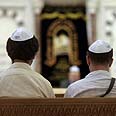
Ynet special: The synagogue industry
Almost everything is for sale during High Holy Day season, ranging from seats to prayers
According to Jewish tradition, Rosh Hashana and Yom Kippur are considered days of repentance and self-reflection, where old scores and hearts are opened – and also wallets. In recent years, the acquisition of a seat at leading synagogues in Israel has turned into a major economic expense, not only in the haredi sector.
For a marked seat, which in many cases is no more than a folding chair, one would have to spend NIS 50 at best (roughly $13) or NIS 7,000 (roughly $1,800) and more at worst. And we haven't even mentioned the most prominent prayers, where people in some Hassidic communities pay tens of thousands of shekels or dollars for the right to replace the cantor.

Hassidim preparing for Holy Days (Photo: Haim Tzach)
"The larger and more upscale the synagogue is, the more expensive the payment," says Aryeh Yoeli of the national-religious camp. "By the way, payment for seats is commonplace mostly at Ashkenazi synagogues. At the Sephardic places, people usually donate without being forced to do so."
Take Jerusalem's great synagogue for example, considered one of the world's largest – accordingly, it usually draws the elite of the Jerusalemite national-religious community. A ticket for two, including a prayer, costs NIS 700 (roughly $180) and includes both Rosh Hashana and Yom Kippur. The synagogues director, Rabbi George Finkelstein, notes that soldiers will be allowed to enter free of charges if there are free spaces.
"The security guards at the entrance to not ask anyone to show their ticket," Rabbi Finkelstein says. "We have 1,500 marked seats, but people can stand." He says that the synagogue attracts Jews from diverse communities and also non-Jews "who wish to get a taste of a Jewish prayer."
Giant prayer tent sold out
While the financial preparations of national-religious Jews or haredim can be summed up with purchasing seats, in the various Hassidic camps the situation is different. The Vizhnitz Hassidim seem to invest the greatest effort, and in recent weeks set up a giant prayer tent on the border of Bnei Brak and Ramat Gan, just east of Tel Aviv. The tent will accommodate 8,000 people.
The Vizhnitz leader, 95-year-old Rabbi Moshe Hagar, will stay at a special mobile home for the duration of period brought to the site especially for him at the cost of NIS 120,000 (roughly $33,000.) On Rosh Hashana, he will be facing the tough task of personally blessing all the worshippers, a process expected to take at least six hours. These blessings are provided free of charge.
However, seats in the tent cost quite a bit, with those closer to Rabbi Hagar going for up to NIS 1,800 (about $480). The rows closest to the rabbi go for as much as people are willing to pay, as the price of a seat can reach NIS 7,000. If you were planning to get in on the action you're out of luck: All seats had been sold out.
Haredi public relations expert Yisrael Cohen says that the lucky ones who got a seat will enjoy an advanced air-conditioning system and more than 220 bathrooms. However, he notes that anyone can come in to watch the sight. "There are no security guards at the entrance. All sorts of curious people always come in and they're received warmly and happily."
'It's an auction in every way'
Yet beyond the "seat sales," the High Holy Day prayers provide more prominent income possibilities – the big hit on this front is being called up to the Torah."In northern Tel Aviv, the price can reach thousands of dollars for being called up to the Torah and hundreds of dollars for the right to open the Holy Ark," says Rabbi Haim Zilber, the deputy director of haredi radio station Kol Chai. "Some people would pay even NIS 36,000 (roughly $10,000) for the right to open the Holy Ark."
During the prayers, which usually last for long hours, dozens of action items are sold to the public, ranging from the right to place ornaments on the Torah scroll (hundreds of shekels) to the reading of the Haftara (tens of thousands of shekels.)
"It's an auction in every way," Rabbi Zilber says. "There was a big controversy over whether this was allowed, but they decided that as the synagogue gains from it, it's permissible. Every person makes a bid, and sometimes some people get together and engage in joint negotiations."
The most expensive item for sale is no doubt the reading of the Haftara of the Mincha prayer on Yom Kippur. Vizhnitz hassidim recount a jeweler who used to purchase it every year at a rate of up to $100,000.
The great sums of money collected through the various sales are mostly used to cover the expenses of the synagogues and various Hassidic camps. As some of the donations are not reported to the Income Tax Authority, synagogue managers shy away from providing accurate figures. And so, for example, members of the Belz Hassidic dynasty refused to talk about the sums ("are you crazy? The Income Tax people are reading your paper!") but agreed to talk about the donations' final destination: Festive meals for all 7,000 Hassidim expected to attend the Holy Day sessions (including 21,000 portions of gefilte fish and rugelach pastries.)










